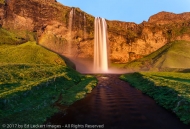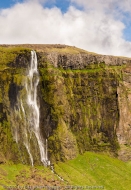


You know it’s going to be an interesting day when you wake up to a power outage caused by the high winds of an Arctic winter storm, and when power is restored to the house and well pump, you realize you still don’t have water pressure because the pipes are now frozen.
For the past couple of weeks I’ve had the privilege of clearing out my late mother’s house in rural Mississippi, and in the process have experienced overnight low temperatures that have routinely fallen below those in both the Pacific Northwest where I live and in Iceland where I recently visited. I’m not complaining – the folks from the Midwest through the Northeast are having a horrible time of it, with the coldest temperatures in decades and up to six feet of snow possible in some areas. No, I just think it’s interesting. So interesting that I want to think about something else. Something warm. Like, Hawaii, for instance.
Back in early 2012 as I was preparing to photograph the May solar eclipse somewhere in North America, I became aware that the last transit of Venus in our lifetimes was going to occur in June of the same year. A transit of Venus occurs when Venus passes in front of the sun from Earth’s perspective. Well, I’d already bought the filter I needed to shoot the solar eclipse, and I could use the same filter to shoot the transit, so why not?
The next question was, where to view it? The first half of the transit would be visible from the west coast of North America, but who wants to see half of an event of this magnitude? No, if I’m going to do this, I’m going to do it right! I’ll witness the entire spectacle from beginning to end! I’ll sit there and watch that tiny little dot for the entire six and a half hours it takes to move across the sun, or I’m not interested!
So I found one of those nifty little online calculators that scientists with no life happily throw together for us and discovered that the best place to witness the entire transit from beginning to end was in the middle of the Pacific Ocean. And this is good thing, because Hawaii happens to be in the middle of the Pacific Ocean, too, and who doesn’t want to go to Hawaii?
So then, like any good resident of Seattle, I started to think about the clouds. I can’t fly all the way to Hawaii for this rare event and get shut down by clouds. I need to be somewhere that’s virtually cloud-proof. The dry side of an island? Perhaps. But what if I could get above the clouds, and at the same time, cut the amount of atmosphere between my lens and the sun? Of course! Mauna Kea! This peak is just short of 14,000 ft., is the location of choice for numerous observatories, and a road goes right to the top! Perfect!
So I made plans to head to the Big Island, and of course I gave myself a little extra time to shoot some of the land-based attractions of the island as well. My first day there I found a cute little beach near the town of Captain Cook. The locals were having a cookout, but I was more interested in the beautiful sunset that was taking place out over the ocean. So too was a couple that I found silhouetted against the bright orange sky.
Then I went out to the water’s edge and did a longish exposure of the waves crashing against the rocks.
The next day I checked out Volcanoes National Park. There wasn’t much lava flow during my visit, but it was still interesting.
Finally, on the day of the transit, I drove up to the Mauna Kea Visitor Information Station at 9,000 ft. and stayed there long enough to get acclimated. Then I hopped in a shuttle and headed for the top, where I sat and photographed the sun at the dusty, windy, cold summit for the next seven hours. And yes, I had on sunscreen, sun hat, sunglasses, solar viewing glasses, warm clothes, and everything needed to stay safe.
So where does the goat cheese come in? Well, for lunch one day I stopped at a cute little restaurant in Hawi Town, the northernmost city on the Big Island. On the menu was “Men Who Stare at Goat Cheese”. As luck would have it, I had just watched the movie The Men Who Stare at Goats the previous weekend, so I asked the waitress what the connection was. She didn’t know – it was just goat cheese on crackers.
Well, as soon as she walked away, the sushi chef behind the counter called to me. “You want to know about the goat cheese story?” It seems that Jeff Bridges, who plays a leading role in that movie, lives in Hawi Town, and came to the restaurant for a snack one day. Not for lunch, just a snack. “What do you have with goat cheese?” So they threw together a goat cheese snack, named it after the movie and put it on the menu!
Hmm. A snack actually sounds pretty good right now. Might have to see what I can find around the house. So until next time, stay warm!
